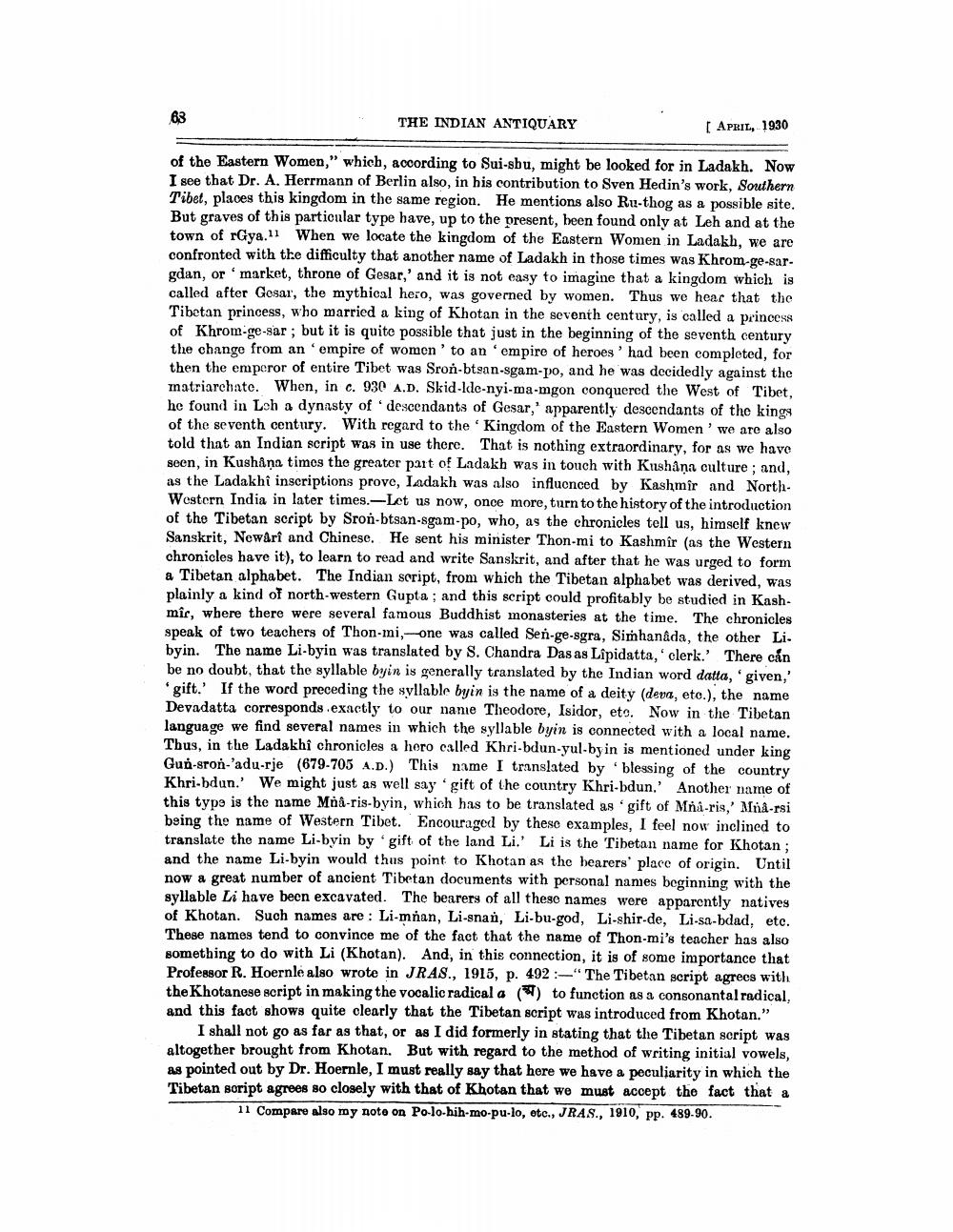________________
THE INDIAN ANTIQUARY
APRIL, 1930
of the Eastern Women," which, according to Sui-sbu, might be looked for in Ladakh. Now I see that Dr. A. Herrmann of Berlin also, in his contribution to Sven Hedin's work, Southern Tibet, places this kingdom in the same region. He mentions also Ru-thog as a possible site. But graves of this particular type have, up to the present, been found only at Leh and at the town of Gya.11 When we locate the kingdom of the Eastern Women in Ladakh, we are confronted with the difficulty that another name of Ladakh in those times was Khrom-ge-sargdan, or market, throne of Gesar,' and it is not easy to imagine that a kingdom which is called after Gesar, the mythical hero, was governed by women. Thus we hear that the Tibetan princess, who married a king of Khotan in the seventh century, is called a princess of Khrom-ge-sar; but it is quite possible that just in the beginning of the seventh century the change from an empire of women'to an empire of heroes' had been completed, for then the emperor of entire Tibet was Sron-btsan-sgam-po, and he was decidedly against the inatriarchate. When, in c. 930 A.D. Skid-de-nyi-ma-mgon conquered the West of Tibet, he found in Loh a dynasty of descendants of Gesar,' apparently descendants of the kings of the seventh century. With regard to the Kingdom of the Eastern Women'we are also told that an Indian script was in use there. That is nothing extraordinary, for as we have seen, in Kushåņa times the greater part of Ladakh was in touch with Kushåņa culture; and, as the Ladakhi inscriptions prove, Ladakh was also influenced by Kashmir and NorthWestern India in later times.--Let us now, once more, turn to the history of the introduction of the Tibetan script by Sron-btsan-sgam-po, who, as the chronicles tell us, himself knew Sanskrit, Newari and Chinese. He sent his minister Thon-mi to Kashmir (as the Western chronicles have it), to learn to read and write Sanskrit, and after that he was urged to form a Tibetan alphabet. The Indian script, from which the Tibetan alphabet was derived, was plainly a kind of north-western Gupta ; and this script could profitably be studied in Kashmir, where there were several famous Buddhist monasteries at the time. The chronicles speak of two teachers of Thon-mi-one was called Sen-ge-sgra, Simhanada, the other Li. byin. The name Li.byin was translated by S. Chandra Das as Lípidatta, clerk.' There can be no doubt, that the syllable byin is generally translated by the Indian word datta, given,' 'gift. If the word preceding the syllable byin is the name of a deity (deva, etc.), the name Devadatta corresponds exactly to our name Theodore, Isidor, eto. Now in the Tibetan language we find several names in which the syllable byin is connected with a local name. Thus, in the Ladakhi chronicles a horo called Khri-bdun-yul-by in is mentioned under king Guň-sron-'adu-rje (679-705 A.D.) This name I translated by blessing of the country Khri-hdun.' We might just as well say gift of the country Khri-bdun.' Another name of this type is the name Mna-ris-byin, which has to be translated as 'gift of Mña-ris,' Mnå-rsi being the name of Western Tibet. Encouraged by these examples, I feel now inclined to translate the name Li-byin by 'gift of the land Li.' Li is the Tibetan name for Khotan; and the name Li-byin would thus point to Khotan as the hearers' place of origin. Until now a great number of ancient Tibetan documents with personal names beginning with the syllable Li have been excavated. The bearers of all these names were apparently natives of Khotan. Such names are: Li-mñan, Li-snan, Li-bu-god, Li-shir-de, Li-sa-bdad, etc. These names tend to convince me of the fact that the name of Thon-mi's teacher has also something to do with Li (Khotan). And, in this connection, it is of some importance that Professor R. Hoernle also wrote in JRAS., 1915, p. 492 -"The Tibetan script agrecs with the Khotanese script in making the vocalic radical a (9) to function as a consonantal radical, and this fact shows quite clearly that the Tibetan script was introduced from Khotan."
I shall not go as far as that, or as I did formerly in stating that the Tibetan script was altogether brought from Khotan. But with regard to the method of writing initial vowels, as pointed out by Dr. Hoernle, I must really say that here we have a peculiarity in which the Tibetan soript agrees so closely with that of Khotan that we must accept the fact that a
11 Compare also my noto on Po-lo-hih-mo-pu-lo, etc., JRAS., 1910, pp. 489-90.




